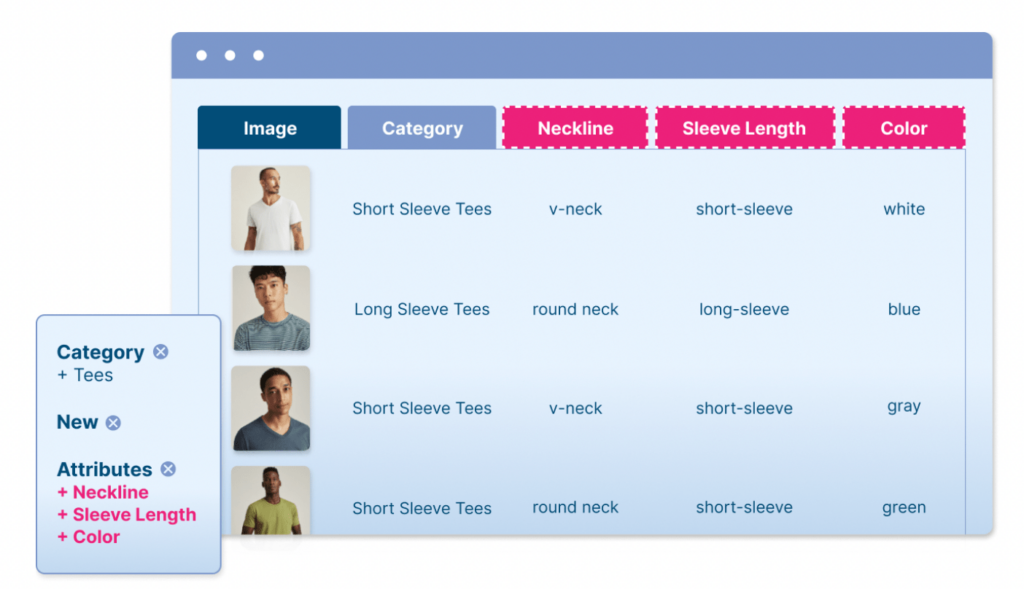When it comes to ecommerce marketing these days, AI seems to indicate “Abundant Information” (or “Advertising Influx!”). The hype around AI — specifically Generative AI — is nearly deafening. With so many vendors claiming AI capabilities, it can be hard to separate what’s real from what’s marketing hype, what’s native AI from what’s bolted-on, and what’s a value-driven use case from what’s smoke-and-mirrors.
By applying a scrutinizing eye, you’ll see there are compelling use cases for Generative AI (GenAI) in ecommerce that are already yielding measurable ROI, particularly in product discovery. As Gartner reports, “Generative AI is increasingly impacting the digital commerce search and discovery experience today.”
Join us as we provide a working understanding of the terminology and technologies involved, identify GenAI use cases that bring sustained value to your ecommerce business and customers, and help you select the right partner(s) to work with for long-term growth.
The ABCs of Generative AI: Getting Our Terms Straight
As you look at tapping into AI and GenAI for ecommerce product discovery, it’s helpful to have a working understanding of some of the terms involved:
Clickstream data
This is the trail of your customers’ activities on your website or mobile app — what they click on, hover over, spend the most active time viewing, search for, add to (or remove from) cart, purchase, etc. Clickstream data is sometimes also called “clickstream analytics” or “click path data,” and clickstream data analysis is AI-powered.
Also, because clickstream is first-party data, leveraging it provides more accurate product rankings, improves security and compliance, and increases customer loyalty.
Transformers (the “T” in ChatGPT)
These are advanced algorithmic models introduced in 2017 that use natural language processing (NLP) to weigh the importance of different words in a sequence. A type of neural network, transformers can improve the accuracy of a variety of tasks — rapidly processing vast amounts of data, learning the contextual relationships between words in a query (regardless of the distance between them), and creating general models that can be fine-tuned for specific functions.
So, when trained on a large set of ecommerce data (your unique use cases, regions, customer clickstream behavior, etc.), transformers can help deliver more attractive, personalized buyer experiences.
If you choose a product search and discovery engine that leverages transformers with clickstream data, they’ll be able to fully understand user queries and return hyper-personalized, highly attractive results and recommendations that also advance specific business KPIs, such as conversions, revenue, inventory balancing, and more.
Large language models (LLMs)
These are also a category of AI models. Trained on massive amounts of text data, LLMs are able to demonstrate natural language understanding and perform generation tasks. LLMs are also typically based on deep learning techniques, particularly transformer architectures. In ecommerce, this allows them to mimic what people want in a given situation.
For example, LLMs can understand that when someone searches for “butter” on a grocery site, the site should display a product like salted butter, not peanut butter. Or, when a U.S. shopper searches for pants, they mean trousers, but someone in the UK may be looking for underwear.
Generative AI (GenAI)
At a high level, GenAI refers to the use of AI models to generate content, responses, or suggestions. GenAI leverages machine learning algorithms (often based on neural networks, such as transformers) for language understanding. In the context of large amounts of clickstream data, GenAI can help power an even more tailored product search and discovery experience, where first-time site visitors and returning buyers can quickly, easily, and enjoyably find attractive products in one session.
While it may sound easy in theory, it’s difficult in practice. A recent study found that less than a third of U.S. shoppers describe their experiences finding products on a retail website as “enjoyable.” And this is a key reason why product search and discovery technology based on GenAI becomes so appealing.
Forward. Fast. The Future of AI in Product Discovery
This comprehensive guide navigates the evolution of product search and discovery, including the future it has with Generative AI and the complexities of emerging tech, so digital leaders can confidently transcend the AI hype and make strategic, future-ready investments in ecommerce tech.
Benefits of Generative AI in Ecommerce
There are a number of customer-facing and back-end GenAI use cases in enterprise ecommerce that provide tangible business value today.
The benefits GenAI offers to ecommerce companies include:
- Enhanced product search and discovery. As Gartner explains, GenAI “allows consumers to search using natural language instead of specific product names or categories. … By providing more context, there is less reliance on filtering and sorting.”
- Differentiation against competitors. Pioneer and adopt cutting-edge technologies that build customer loyalty and buzz.
- Time-savings for merchandisers. Automate repetitive tasks and free up merchandisers’ time for more strategic activities.
- Increased on-site engagement, loyalty, and conversions. This is possible via providing more targeted, attractive, and meaningful experiences.
Generative AI Use Cases in Ecommerce
In many ways, the future of product discovery is already upon us, and GenAI plays a key role.
Forward-looking ecommerce retailers are integrating GenAI into existing product discovery functionality to meet buyers’ complex needs. This is happening by combining GenAI capabilities with customer behavioral data for better personalization, connecting the tech to their product catalog to improve search infrastructure, and more initiatives.
And leading product discovery vendors are already at the forefront of using GenAI to drive value for ecommerce companies: helping them harness the technology to create “sticky” and revenue-generating experiences.
Check out these three examples of how Generative AI can generate business success:
AI Shopping Assistant
Constructor’s AI Shopping Assistant (ASA) is a conversational product discovery tool, blending GenAI with Constructor’s user-level personalization technologies and ability to optimize for ecommerce KPIs.
Named in the aforementioned Gartner report, ASA allows buyers to use the search bar on an ecommerce site to pose detailed questions or even engage in conversations. They then receive recommendations tailored to their unique preferences, history, and intent — and reflective of the site’s real-time inventory.

ASA is ideal for shoppers who come to an ecommerce site with a general idea of what they want, but need help selecting best-fit items. This spans from starting a new hobby to finding a birthday gift for a small child or even looking for something to cook for dinner. Much like a trusted in-store associate, ASA gives tailored advice and suggestions that instill confidence in purchase decisions.
It’s a win-win for both shoppers and businesses. Shoppers benefit from this, as tailored expertise expedites the journey from goal to purchase. For ecommerce companies, it’s a boon to have shoppers do research on-site, rather than on Google or Amazon — making it easier to drive conversions.
Ecommerce companies across sectors — such as grocery, apparel, and general retail — have already implemented ASA with high-impact results.
For example, a major U.S.-based grocery retailer uses Constructor’s ASA to automatically generate recipes that shoppers search for on their site. The ingredients shown are items the grocer has in-stock and are personalized to the shopper at hand. (As in, if the recipe calls for milk, and the shopper tends to buy organically, then options for organic milk appear.) Plus, ASA makes it easy for shoppers to add all the ingredients to their cart directly from the recipe page.
While most frequently used to enhance search and “conversational commerce,” ASA has other use cases as well and can be implemented flexibly and easily on ecommerce sites.
Dynamic Collections
Constructor also applies GenAI to create dynamic collections, or personalized landing pages automatically generated for each shopper based on their behavior and intent on-site.
You can think about it like this: Each time a customer interacts with website or app content, they’re essentially “voting” for products they want to see. An AI-native search engine like Constructor’s takes note, dynamically assembling and re-ranking products to reflect that shopper’s interests and intent.
Picture this in action on outdoor retailers’ sites, where shoppers might search for products to perform for a specific hobby. For instance, when a customer searches for “snowboarding gear,” dynamic Collections pages powered by GenAI populate a well-rounded list of products that both address the query and reflect the shopper’s preferences — such as boots, helmets, goggles, neck gaiters, bindings, and more.
Attribute Enrichment
GenAI can also maximize ecommerce merchandisers’ efficiency to address a common pain point: missing or mislabeled product catalog data.
When an item has key product attributes missing, shoppers won’t be able to find it during a search, and ecommerce companies may miss out on a sale. But with Attribute Enrichment, merchandisers can bridge the gaps in product catalogs. This GenAI-native tool enriches product data by creating attributes and categories based on shopper trends and clickstream data, exposing consumers to a broader range of new items and eliminating time-consuming work for merchandisers.

A large fashion and apparel brand uses Constructor’s Attribute Enrichment to create a map of synonyms generated from queries. For example, running the attribute “fabric” through Attribute Enrichment led to the following values being automatically created:
- Faux: faux fur, faux leather
- Satin: satin boxer, silky, silk, shiny, shine
- Woven: fabric, knit
- Cotton: cotton underwear, 100 cotton, superchill cotton
- Corduroy: corduroy, corderoy, cordoroy, cord, cords
- Stretch: stretchy, flex, elastic waist
- Wool: wool coat, wool blend, 100% wool, merino wool blend
- Fleece: fleece lined, fleece and love, ott fleece, fleece jogger, cloud fleece, reverse fleece, lumberjane fleece
Not only are the attributes created usable for filtering, but the AI-powered tool automatically picks up on macroeconomic shopping trends, as can be seen by the populated attribute ‘lumberjane fleece.’
And because these trends change daily, ecommerce sites can move at the speed of social media — without sacrificing precious merchandiser time.
Generative AI in Every Situation?
There’s great potential and value in applying GenAI to improve product discovery. But it’s important to recognize it’s not the only useful tool in your toolbox.
As our CEO Eli Finkelshteyn explained in a recent webinar with AWS: “‘What’s my Generative AI strategy?’ is the wrong way of looking at it. It should be more along the lines of: ‘What’s my strategy?’ and then ‘Can Generative AI help with it?’ Like with any tool, it’s a means to an end.”
He expounds on this in a recent interview with The Ecomm Manager, too: “Ecommerce companies need to look at: What problem or pain point are we trying to solve? How can we use [Generative AI], other AI, or even non-AI-based technology to offer a better way? When you can blend what’s new and cool with what’s genuinely useful — creating something that shoppers will use repeatedly and that drives value for the business — then you’ve set yourself up for success.”
The Future of Product Discovery Is Within Reach
Looking to learn more about the role of GenAI and other emerging technology in the future of product discovery? See how to thoughtfully harness and stay ahead of developments in AI to deliver hyper-personalized, engaging customer experiences that future-proof your business and increase revenue.
Forward. Fast. The Future of AI in Product Discovery
Don’t just learn about the evolution of product discovery. Understand its origins and the future it has with Generative AI so you can confidently make strategic, future-fit investments in ecommerce tech.

